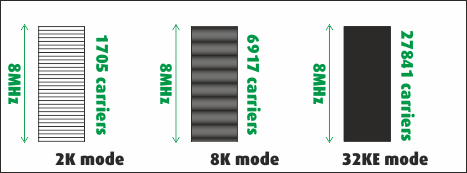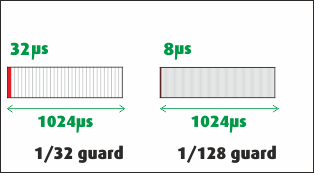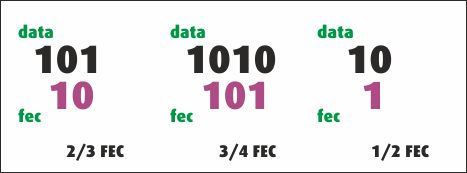Freeview modes - a simplified explanation
 Brian Butterworth published on UK Free TV
Brian Butterworth published on UK Free TV As mentioned in How digital television works Freeview signals can be broadcast in a number of different "modes", which are a combination of five parameters. Some of these have changed over the years because the increase in computing power has made more efficient methods of broadcasting cheap enough to fit in a set-top box - it is now possible to broadcast high definition television or more standard definition services on the same physical wavelength.
As some of the ideas that are implemented would fill a text book by themselves, I have presented the concepts in a simplified way.
Sub-carriers
Each Freeview multiplex is broadcast within an 8MHz channel that was originally allocated to analogue television. Rather than being a single broadcast, the channel is split into a number of different signals that sit next to each other.The original digital terrestrial broadcasts (from the launch of ONdigital) used 1,705 sub signals (referred to as 2k mode) about 4,600 Hz apart. After switchover 6,817 subcarriers (8k mode) means the signals are 1,170 Hz apart, with the high definition service using 27,841 (32ke) subcarriers just 280Hz apart.

It is possible to space carriers so close together because they are carrying digital information, in the analogue domain the problem with sidebands would render a similar system useless.
Symbol duration
For reasons detailed below, the information is not transmitted in single bits on each carrier, but as groups of bits which are referred to as "symbols". Each symbol is held in the transmission system for a given duration, 1024 us. The longer this time is, the less information is carried, but too short a duration for each symbol would not allow the receiver to detect the information correctly.Guard interval
Each subcarrier also uses a guard interval, which turns off each carrier as part of the transmission cycle. With SD broadcasts, this is 1/32th of the symbol time (32us), on HD it is 1/128th (8us). The guard intervals start each symbol and exist to deal with the problems of multipath - where the signal is being received directly and also by reflections.
Forward error correction
In non-synchronous digital transmission systems, such as those used for the internet, the presence of data corruption between the sender and receiver can be signalled back to the source and the data resent.However, a digital broadcast is a one-to-many unidirectional system, with no ability to ask for data to be resent.
For this reason, the transmissions use "forward error correction", which is a system that allows a certain level of errors to be detected.
The most basic form of a forward error correction (FEC) would be to transmit each bit twice - as long as each bit was sent along a separate subcarrier, then a single bit loss on one carrier could corrected by using the one sent on the other carrier. However, this is very inefficient, as it reduces the useful capacity of the system by half.

So, instead the DVB-T system uses a Punctured Convolution coding system. Instead of sending each bit twice, bits are grouped and then a code that describes the bits in a way that a single bit error can be detected and corrected most of the time.
Quadrature amplitude modulation
In the above descriptions, the word "symbol" was used to describe what is transmitted. You may have thought that a digital system would transmit information on the subcarriers as bits. However, doing this in a broadcast system is actually unproductive.For this reason, quadrature amplitude modulation is used. This takes the incoming bits and encodes them in groups. The most basic form encodes bits two at a time, using sine (Q) and cosine (I) functions that are then added to the main carrier. In effect "00" is encoded as -Q-I, "11" as +Q+I, with "01" and "10" being +Q-I and -Q+I.

At the next level, as used for DVB-T, the bits are encoded in groups of four bits (16QAM) or eight bits (64QAM), with DVB-T2 being groups of 16 bits (256QAM).
UK Freeview modes
There are 10 modes defined for use in the UK, these are:- Mode 1: DVB-T 1705 (2K) carriers, 64QAM mode, FEC=2/3, 1/32 guard = 24.13Mbps
- Mode 2: DVB-T 1705 (2K) carriers, 16QAM mode, FEC=3/4, 1/32 guard = 18.1Mbps
- Mode 3: DVB-T 6817 (8K) carriers, 64QAM mode, FEC=2/3, 1/32 guard = 24.1Mbps
Mode 4: DVB-T2 6913 (8KE) carriers, 64QAM mode, FEC=4/5, 1/32 guard = 34.7MbpsunusedMode 5: DVB-T2 27841 (32KE) carriers, 256QAM mode, FEC=3/5, 1/128 guard = 36.1Mbpsunused- Mode 6: DVB-T2 27841 (32KE) carriers, 256QAM mode, FEC=2/3, 1/128 guard = 40.2Mbps
- Mode 7: DVB-T 6817 (8K) carriers, QSPK mode, FEC=1/2, 1/32 guard = 6.0Mbps
- Mode 8: DVB-T 6817 (8K) carriers, 64QAM mode, FEC=3/4, 1/32 guard = 27.1Mbps
"high capacity commercial multiplex mode". Mode 9: DVB-T2 27265 (32KN) carriers, 256QAM mode, FEC=3/5, 1/128 guard = 35.2Mbpsunused- Mode 10: DVB-T2 27265 (32KN) carriers, 256QAM mode, FEC=2/3, 1/128 guard = 39.2Mbps
- Mode 11: "Northern Ireland mode" details TBC
Diagram showing capacity for each mode:

Help with Television sets?
Saturday, 26 November 2011
J
johnc11:03 AM
Thanks, Dave - that explains things anyway. Having studied the user manuals more diligently, I now understand what 'HD Ready' (as on the TV set) actually means!
Ah well, at least both boxes are rented, so upgrading shouldn't be a problem
| link to this comment |
Thursday, 15 December 2011
S
Subash12:02 PM
Watford
I am in Watford, Herts.
I have Technika HD ready LCD with Technika HD STB, HDMI connected. The antenna is Grp:A Yagi - in the 2nd floor bd-rm, against the window. I have difficulty getting/saving the HD channels. Sometimes I get them after repeated re-set/retune. Even after I have got them, suddenly "No Video Audio available" & upon retune no HD channels come up! I re-aim the antenna slightly everytime I retune, but same as before - even if I got the HD channels they disappear?
Kindly help please? Thanks & regards.
| link to this comment |
Subash's: mapS's Freeview map terrainS's terrain plot wavesS's frequency data S's Freeview Detailed Coverage
Subash: You may have to wait until switchover to get HD.
If you are receiving from Crystal Palace (134 degrees, aerial horizontal), then the power of the transmitter on C31 (the HD services) is much lower than the other multiplexes. This is because other transmitters are also using C31 in much closer proximity that the other channels CP uses.
The predictor suggests that you might get a pretty good reception off Sandy Heath. Unfortunately Sandy Heath is one of those transmitters which uses C31 and so you could be suffering interferene from it, or it could be the weaker HD signal that isn't reaching your aerial (or a mixture of the two).
Perhaps you could re-site the aerial so that it is screened from Sandy Heath. For example, by mounting it on one side of the house so that the house acts as a shield for the signal from SH. That said, if you do that, you may be reducing the height of the aerial thereby reducing your chances of picking up HD from CP.
Bear in mind that switchover at CP is only four months away and that any remedial work carried out (irrespective of whether it is successful) will only be of benefit for until switchover.
Your other possibility is to use Sandy Heath which has switched over and therefore carries HD servies. Of course the disadvantage is that you will get different regional programming (Anglia instead of London) for standard definition BBC and ITV.
| link to this comment |
Friday, 16 December 2011
S
Subash10:50 AM
Watford
Kind regards & grateful thanks for helpful information. I will try out as suggested. As you say sw-over is less than 4 months away; & the reception quality even as SD very good.
The signal level is 100% & the quality is around 70% & never less than 40%. I have also noticed that the transmitted level is "below average" signal. So, I might just postpone getting the HD multiplex until sw-over.
Keep up the expertise & help us as needed!
Best wishes - not just Seasonal, but for all time to come! = "Subash".
| link to this comment |
Subash's: mapS's Freeview map terrainS's terrain plot wavesS's frequency data S's Freeview Detailed Coverage
Friday, 6 January 2012
Félim
9:48 AM
9:48 AM
Brian,
An excellent presentation on the magic of digital TV! Is it available for download as a PDF for off-line reading?
One minor error I noticed though. Shouldn't "1/32th" be "1/32nd"?
| link to this comment |
S
Subash11:16 AM
Watford
"Brian", hope still not too late for SEASONAL GREETINGS? After all it is the 12th day!
I just finished reading your article, using the link "digital" above.
To have on hand such useful information very expertly condensed & explained for "non broadcast engineers" merits the immense appreciation of mine, & others who I am sure would have enjoyed it & found it useful.
Kind regards. - "Subash"
| link to this comment |
Subash's: mapS's Freeview map terrainS's terrain plot wavesS's frequency data S's Freeview Detailed Coverage
Tuesday, 17 January 2012
Subash: Thanks for your greetings. I am glad you found the article helpful.
| link to this comment |
Wednesday, 22 February 2012
P
Peter Blake4:04 PM
Penzance
Hello Briantist, live at TR19 7RE and notice that the St Just transmitter does not broadcast all the TV/Radio channels that the main Redruth transmitter does. Is this likely to improve soon, and if so do you know when, please? Regards, Peter
| link to this comment |
Peter's: mapP's Freeview map terrainP's terrain plot wavesP's frequency data P's Freeview Detailed Coverage
Sunday, 26 February 2012
Peter Blake: It won't change, see Will there ever be more services on the Freeview Light transmitters? | ukfree.tv - independent free digital TV advice for details.
| link to this comment |
Select more comments
Your comment please!